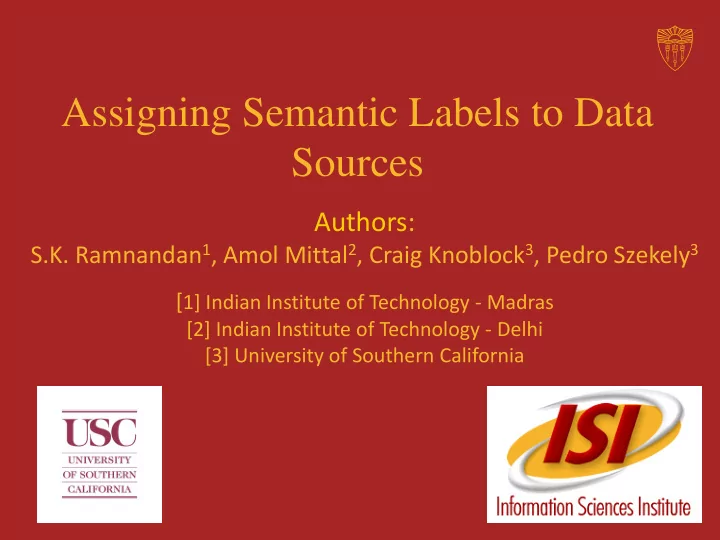

Assigning Semantic Labels to Data Sources Authors: S.K. Ramnandan 1 , Amol Mittal 2 , Craig Knoblock 3 , Pedro Szekely 3 [ 1] Indian Institute of Technology - Madras [2] Indian Institute of Technology - Delhi [3] University of Southern California
Introduction Motivation: - To automatically construct a semantic model of a set of data sources using domain ontologies selected by user Applications: - Provides support to automate many tasks - Data integration - Source discovery - Service composition - Building knowledge graphs - Manual description - tedious & time-consuming
What is a semantic model? Description of the source in terms of the concepts and relationships defined by the domain ontology Domain Ontology bornIn nearby birthdate isPartOf livesIn Place name Person organizer postalCode location ceo name City State worksFor Event state title Organization phone startDate name Data Source Column 1 Column 2 Column 3 Column 4 Column 5 Bill Gates Oct 1955 Microsoft Seattle WA Mark Zuckerberg May 1984 Facebook White Plains NY Larry Page Mar 1973 Google East Lansing MI
Example semantic model bornIn City state worksFor Person State name Organization name birthdate name name Column 1 Column 2 Column 3 Column 4 Column 5 Bill Gates Oct 1955 Microsoft Seattle WA Mark Zuckerberg May 1984 Facebook White Plains NY Larry Page Mar 1973 Google East Lansing MI
Semantic Labeling Step Assigning a class or data property (semantic type) from the ontology to each attribute in the source Person Person Organization City State name birthdate name name name Column 1 Column 2 Column 3 Column 4 Column 5 Bill Gates Oct 1955 Microsoft Seattle WA Mark Zuckerberg May 1984 Facebook White Plains NY Larry Page Mar 1973 Google East Lansing MI
Overall approach - semantic modeling Taheriyan et al., ISWC 2013, ICSC 2014 Problems with model-based machine learning techniques (like CRF): • Low prediction accuracy for numeric data • Training time scales poorly as no. of ontology data properties increases
Overall Approach (SemTyper) Holistic view of data values to capture characteristic property of semantic type Textual Data : TF-IDF Cosine Similarity Numeric Data: Kolmogorov-Smirnov Test Top-k suggestions returned to the user based on the confidence scores
Approach to Textual Data
Approach to Numeric Data Candidate Statistical Hypothesis tests: - Welch’s t-test - Mann-Whitney U-test - Kolmogorov-Smirnov Test
Handling noisy datasets How to infer if data is textual or numeric in a noisy source? Training time : fraction of numeric values • < 60% - trained as purely textual • > 80% - trained as purely numeric • else - trained as both textual and numeric Prediction time : fraction of numeric values > 70% - tested as numeric data • else - tested as textual data • Thresholds empirically chosen using coarse grid search Measuring label prediction accuracy on held out set •
Datasets (Evaluation) Purely textual data Museum domain: 29 museum data sources (Taheriyan et al.) • Purely numeric data • City domain: 30 numeric data properties from City class in Dbpedia Partitioned into 10 data sources Mixture of textual & numeric data • City domain: 52 data properties from City class in DBpedia • Weather, phone directory and flight status domains (Ambite et al.)
Metrics (Evaluation) Mean Reciprocal Rank Interested in rank at which correct semantic label is predicted Average Training Time
Evaluation (Textual data- Museum domain)
Evaluation (Numeric data- City domain)
Evaluation (Mixture data- City domain)
Evaluation (Mixture data- other domains)
Related Work Using model-based machine learning techniques • Goel et al. (ICAI 2012), Limaye et al. (PVLDB 2010), Mulwad et al. (ISWC 2013) Extract features from individual data values and build graphical model Do not extract characteristic properties of column data as a whole Training graphical models not scalable – explosion of search space Using external knowledge • Venetis et al. (VLDB 2011), Syed et al. (SWSC 2010) Leverage knowledge on Web to label individual data values Restricted to domains and ontologies - huge amount of extracted data Highly ontology specific – models generated from specific ontologies Stonebraker et al. (CIDR 2013) Address problem of schema matching Draw inspiration in combining collection of experts
Conclusion Label Prediction Accuracy Our approach improves on accuracy of competing approaches on wide variety of domains Efficiency & Scalability About 250 times faster than Conditional Random Fields based semantic labeling technique Capable of handling noisy datasets Ontology agnostic Learns semantic labeling function with respect to ontologies selected by users for their application
Recommend
More recommend